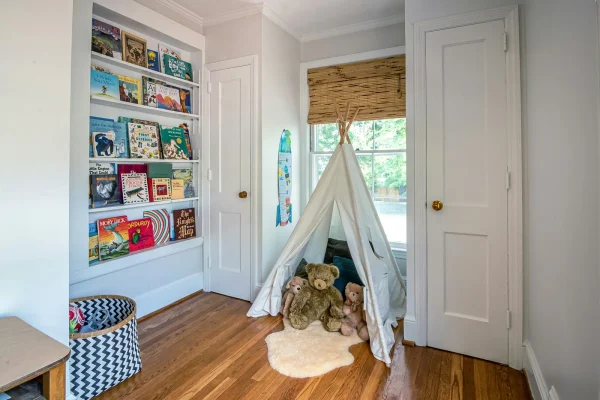No judgment here—every parent hits that point when the playroom stops being a play space and starts looking like a toy explosion zone. Whether it’s a growing mountain of stuffed animals, action figures in every corner, or a LEGO minefield underfoot, taming the chaos is no small feat. But with a few smart strategies, reclaiming the room (and your sanity) is totally doable—no full weekend or Pinterest-perfect makeover required.
Know What You Want From the Space Before You Declutter the Playroom
Start by deciding how you want the playroom to function—creative play, quiet time, or active play? Knowing your goal helps you make better decisions when it’s time to declutter. Whether you want a reading nook, an art table, or just clear floor space during playtime, defining the space’s purpose helps determine how many toys should stay. For simple but effective decluttering tips, understanding the intended use of the space is key to making the right choices.
Use Storage Bins that Match the Way Your Kids Actually Play
f your kids love building towers or dress up, your storage solutions need to support that. Use open storage bins for everyday items and lidded ones for less-used things like art supplies or sports equipment. Matching toy storage to play habits makes it easier for your child to clean up and encourages them to put things back. It’s a good activity to add to their list of cleaning tasks.
Create Zones for Stuffed Animals and Small Toys

To avoid chaos, create zones for specific types of kids toys—a basket for stuffed animals, a tray for lego sets, and zipper pouches or bins for small toys. This approach uses less storage space and prevents everything from blending into a single overwhelming mess. Bonus tip: Use your wall space to keep items off the floor. You can also reuse empty boxes as extra storage for larger items. Just make sure to put a label on each box to keep everything in an organized way.
Keep Toy Clutter in Check With a Simple Trade-Off Rule
One of the best ways to deal with your current toy situation is the “one-in, one-out” rule. When new toys come in, have your kids choose one to donate. It’s a simple way to control how many toys live in your home while teaching them to value what they already have. Remember, while it looks fun, it’s better not to have all the toys cluttering the entire playroom. Have your children choose the toys that make the most sense to keep at home.
Display the Favorites, Hide the Rest in A Dedicated Toy Storage
Not everything needs to be out at once, especially during playtime. Display favorite toys on a bottom shelf or a rolling cart, and store toys your kids aren’t into at the moment. This keeps the room fresh and exciting without overstimulation. Rotating and creating a decluttering routine also prevents forgotten items from taking up space and lets you see what your kids are actually playing with.
Keep A Clear Floor Space to Declutter Playroom Effectively

Nothing makes a space feel messier than cluttered floor space. Limit the number of large toys on the ground and use vertical storage solutions whenever possible. Getting items off the floor makes the playroom easier to vacuum and more inviting for actual child’s play. More floor space means you get to stay organized for a longer time. Just like when you declutter the kitchen in your house, keeping things off the floor makes it easier to maintain an organized, functional space.
Use a Toy Time-Out Bin to Manage Clutter Without Drama
Got toys that keep causing fights or are always left out? Give them a break in a “toy time-out” bin. It’s a brilliant idea that gently teaches kids to take care of their things. You’re not punishing them—you’re giving them space to appreciate their toys again. And it keeps your playroom from spiraling into chaos.
Use Color-Coded Bins to Make Playroom Storage Easily Accessible
Color-coding is a simple and effective way for parents to keep playroom storage both functional and accessible. Assign specific colors to different toy types—blue for crafts, green for stuffed animals, yellow for furniture, and red for building blocks. You can also organize by a fun rainbow order to make it visually appealing and easy to follow. You can easily get all the required materials from your children’s art supplies or from a nearby shop. Even toddlers (ages 1/2–4) can start recognizing colors and learning to put things back in the right spot. It’s a system that grows with your child, making organization a game they can enjoy!

